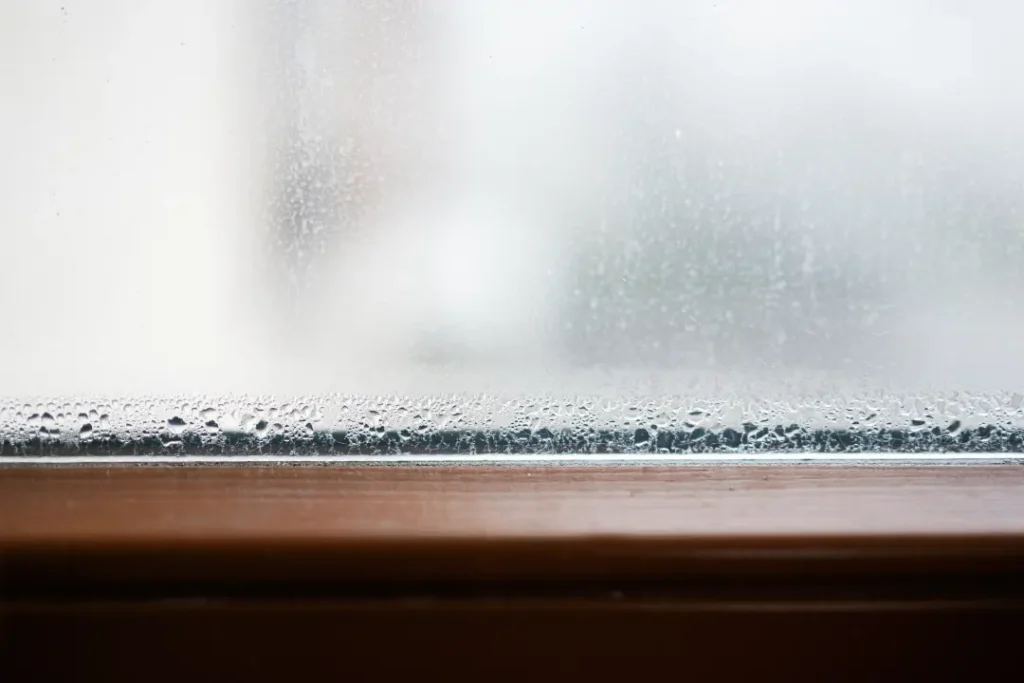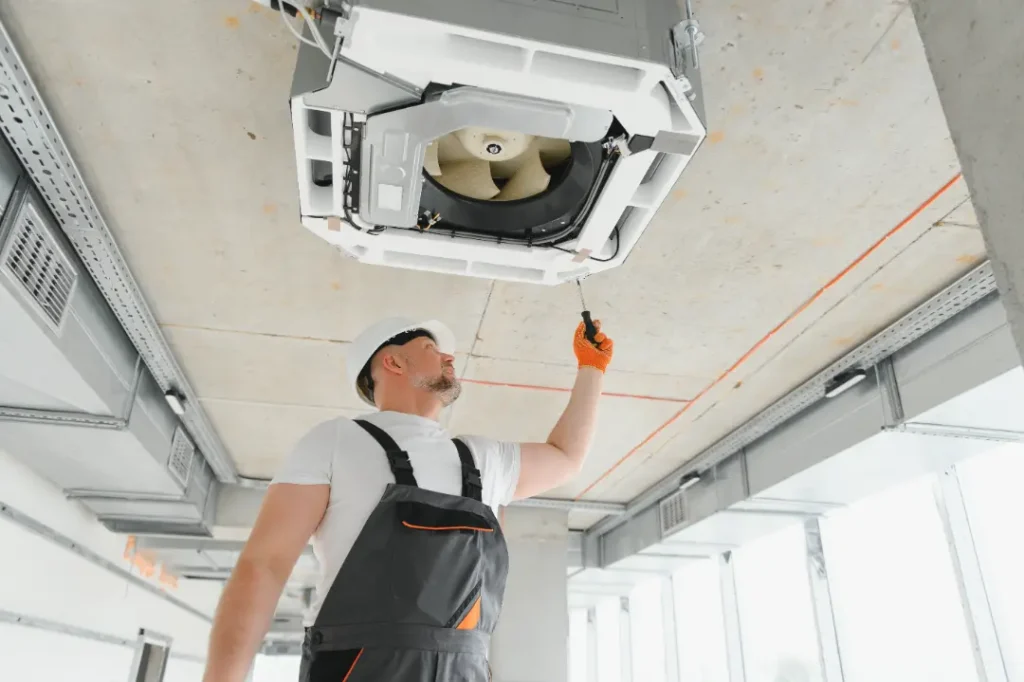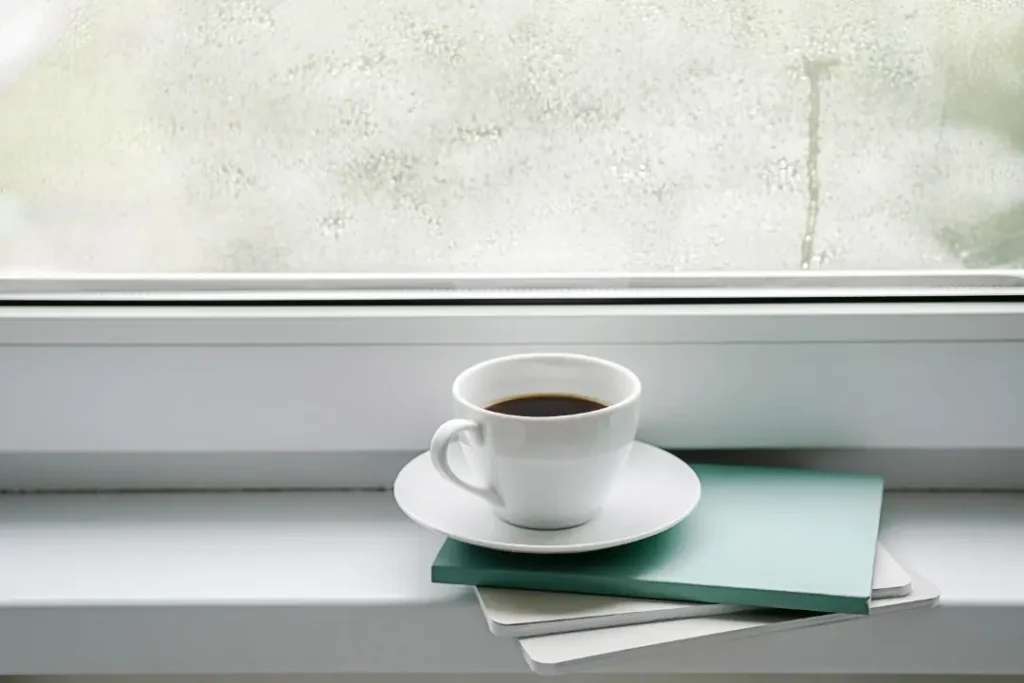Condensation is a common issue in many homes, often leading to mould, dampness, and structural damage.
Learning how to treat condensation is crucial to maintaining a healthy living environment.
This article will guide you through immediate steps and long-term solutions to manage and eliminate condensation effectively.
Key Takeaways
- Condensation in homes can lead to serious issues like mould growth, moisture damage, and health risks; it is essential to address it promptly.
- Effective moisture management strategies include ensuring proper ventilation, using dehumidifiers, and maintaining warmer surface temperatures through insulation.
Experiencing Condensation Issues in Your Home?
Have you ever woken up to find your windows streaming with water or noticed damp patches creeping up your walls? These are common signs of a condensation problem in your home. Daily activities like cooking, showering, and drying clothes indoors release moisture into the air, eventually condensing on cooler surfaces like windows and walls. When condensation occurs frequently, it can lead to mould growth and damage to window frames, ultimately affecting both your property and health.
Damp walls and surfaces are not just unsightly; they can deteriorate over time, leading to costly repairs. To stop condensation and maintain a healthy living environment, it is vital to address these issues as soon as they arise.

Understanding Condensation
Condensation occurs when warm, moist air comes into contact with a cold surface, causing the water vapour in the air to turn into liquid water. This is a common issue in areas with high humidity, such as kitchens and bathrooms.
When condensation forms, it typically appears as droplets on windows and walls, especially in colder months when the difference between indoor and outdoor temperatures is more pronounced. Areas with poor ventilation are particularly susceptible to problems with condensation on windows. If left unchecked, condensation can lead to mould growth and damage to surfaces.
Effectively stopping condensation requires managing indoor moisture levels and maintaining warmer surface temperatures. Address immediate moisture sources and implement long-term strategies for insulation and ventilation.
Immediate Steps to Reduce Condensation
Taking quick action to reduce condensation is essential in preventing more serious issues like damp and mould.
Here are some simple yet effective steps you can take:
- Wipe down cold surfaces after activities like cooking or showering to remove excess moisture.
- Use a squeegee to clear moisture from bathroom surfaces.
- Keep extractor fans running to help expel excess humidity quickly.
Proper ventilation is key. Open windows or use vents during and after cooking or bathing to let moisture escape. Cover pots while cooking to reduce water vapour and immediately wipe down wet surfaces to prevent buildup.
Maintaining a consistent home temperature of at least 14°C helps reduce condensation on cold surfaces. Also, move furniture away from external walls to improve airflow and avoid damp spots. These small, practical steps can make a big difference in controlling condensation in your home.
Improving Ventilation
Effective ventilation is essential for managing moisture levels and preventing condensation in your home. Using extractor fans in kitchens and bathrooms during and after use helps eliminate steam and lower humidity levels, contributing to better air quality and fewer condensation issues.
For a more comprehensive solution, consider whole-house ventilation systems that provide continuous airflow throughout your home. These systems significantly enhance air circulation, reducing moisture buildup and preventing condensation. Additionally, simple measures like opening windows during moisture-generating activities and keeping doors closed in these areas can further improve ventilation.
Proper air circulation involves more than just opening windows. Ensure that air vents and air bricks are unobstructed to allow for effective ventilation. Moving furniture at least 50 mm away from external walls will enhance airflow and help eliminate damp spots. By improving ventilation, you not only create a healthier indoor environment but also significantly reduce the risk of condensation.
Using Dehumidifiers
Dehumidifiers are a powerful tool in the fight against condensation. These devices work by extracting moisture from the air, helping to lower humidity levels and prevent condensation from forming. By pulling in warm air, cooling it to extract moisture, and then releasing drier air back into the environment, dehumidifiers can significantly improve air quality.
Different types of dehumidifiers cater to various needs. Desiccant dehumidifiers are perfect for areas with draperies or cloth furnishings, reducing moisture without adding heat. In high-humidity areas like basements, dehumidifiers can make spaces more comfortable and less damp.
Dehumidifiers are effective when used correctly. Set them to maintain humidity between 30% and 50% to prevent condensation without creating overly dry air. Regular cleaning and emptying of the water reservoir ensure efficient operation and longevity.
Insulating Your Home
Insulation plays a crucial role in reducing condensation by maintaining warmer surface temperatures. Installing double glazing and loft insulation significantly reduces heat loss, which helps manage condensation. Proper insulation not only prevents heat from escaping but also keeps surfaces warm, reducing the likelihood of condensation forming.
Loft insulation is particularly important, as a significant portion of heat escapes through uninsulated roofs. Properly installed loft insulation can lead to substantial savings on energy bills and improve overall home comfort. If you’re considering a DIY project, ensure there are no existing damp problems and that the space is easily accessible.
Besides loft insulation, consider cavity wall insulation, insulating plaster, or boards to keep internal surfaces warm. Clear window vents and move furniture away from external walls to enhance airflow and reduce damp spots.
Installing Humidistat Extractor Fans
Humidistat extractor fan fans are an intelligent solution to managing humidity levels in key areas of your home. These fans activate automatically based on humidity levels, ensuring that they turn on before condensation occurs. Installing humidistat extractor fans in moisture-prone areas like kitchens and bathrooms can significantly reduce the risk of condensation.
The Dryzone Humidistat Air Vent, for example, is designed to be quiet, powerful, and energy-efficient, providing intelligent humidity control. By automatically adjusting to the humidity levels in your home, these fans help maintain optimal air quality and prevent humid air buildup.

Addressing Mould and Dampness
Excess moisture and condensation can often lead to mould and dampness in your home. To prevent mould accumulation, regularly wipe down affected surfaces. If mould has already developed, you may notice small black spots in poorly ventilated areas, such as corners and behind furniture.
To effectively prevent mould growth, it’s crucial to reduce humidity levels and ensure proper ventilation. Avoid overfilling wardrobes to allow for adequate air circulation. Additionally, consider using mould-inhibiting paints and sprays to further mitigate the effects of condensation and mould. By taking these proactive steps, you can maintain a healthier living environment and protect your home from the damaging effects of mould.
Long-Term Solutions to Prevent Condensation
For lasting protection against condensation, implement long-term solutions such as whole house ventilation systems. These systems provide continuous airflow, reducing stale air and preventing condensation buildup. Mechanical Ventilation Heat Recovery (MVHR) systems can recover up to 95% of expelled heat, making them energy-efficient and effective for maintaining humidity levels.
Keeping your home consistently heated at a low temperature can also prevent condensation on surfaces by maintaining adequate warmth. Installing units like the Vent Axia PIV can circulate clean, dry air throughout the property, effectively combating mould and condensation.
Investing in these long-term solutions offers a permanent, cost-effective method to stop condensation and enhance indoor air quality.
Protect Your Home with Environ Property Services Expert Condensation Solutions
When it comes to addressing condensation issues in your home, the expertise of professionals can make all the difference. At Environ Property Services, we specialise in mould and condensation removal, helping homeowners in London reclaim their living spaces from the damaging effects of moisture.
Our dedicated team understands the complex nature of condensation problems, providing tailored solutions to ensure a healthy and comfortable environment. With years of experience and a proven track record, we treat the symptoms and address the root causes of condensation to keep it at bay for the long term.
Our comprehensive services include professional damp surveys to identify moisture sources and potential structural issues in your property. We also offer effective treatments for your home.
Take action today and book your condensation survey with Environ Property Services. Our experts are ready to help you create a safe and comfortable living space. Contact us now to schedule your consultation.
Practical Tips for Everyday Moisture Management
Daily moisture management is crucial to preventing condensation. Drying clothes outdoors significantly reduces indoor humidity. Using lids on cooking pots minimises moisture release, and maintaining a home temperature of at least 18°C reduces condensation risk, especially when dealing with moisture-laden air.
Keep external walls free from furniture to allow better air circulation, which helps in reducing condensation. By adopting these practical tips, you can manage moisture more effectively and prevent condensation problems in your home.

Monitoring and Maintenance
Regular monitoring and maintenance are crucial to keeping condensation at bay. Frequently check for signs of moisture, especially in damp-prone areas. Regular cleaning of ventilation systems, like extractor fans and dehumidifiers, enhances efficiency and lifespan.
Adjusting humidity levels is essential. Set your dehumidifier to maintain levels between 30% and 50% to prevent condensation without overly drying the air. Staying vigilant and performing regular maintenance ensures a healthy, condensation-free home environment.
Frequently Asked Questions
What causes condensation in my home?
Condensation in your home is primarily caused by warm, moist air contacting cold surfaces, leading to the conversion of water vapour into liquid. This is particularly prevalent in high-humidity areas like kitchens and bathrooms.
How can I reduce condensation in my home quickly?
To reduce condensation quickly in your home, wipe down cold surfaces after generating steam, use extractor fans, and keep windows open for ventilation. Maintaining a consistent temperature and using dehumidifiers will further help manage moisture levels effectively.
How can I reduce condensation in my home?
To reduce condensation, ensure you use your tumble dryer properly with adequate ventilation, maintain fresh air circulation, and consider installing double-glazed windows to keep surface temperatures warmer.
Conclusion
Condensation is a common yet manageable issue in many homes. By understanding how condensation forms and taking immediate steps to address it, you can prevent the long-term damage and health risks associated with excess moisture. Strategies such as improving ventilation, using dehumidifiers, and insulating your home are effective ways to combat condensation.For those seeking lasting solutions, we recommend turning to Environ Property Services, your trusted mould and condensation management expert. Our comprehensive services ensure that your home remains a healthy living environment. Remember, regular monitoring and maintenance are essential to keeping condensation at bay. Take action today with Environ Property Services to create a comfortable, condensation-free home for you and your family!

